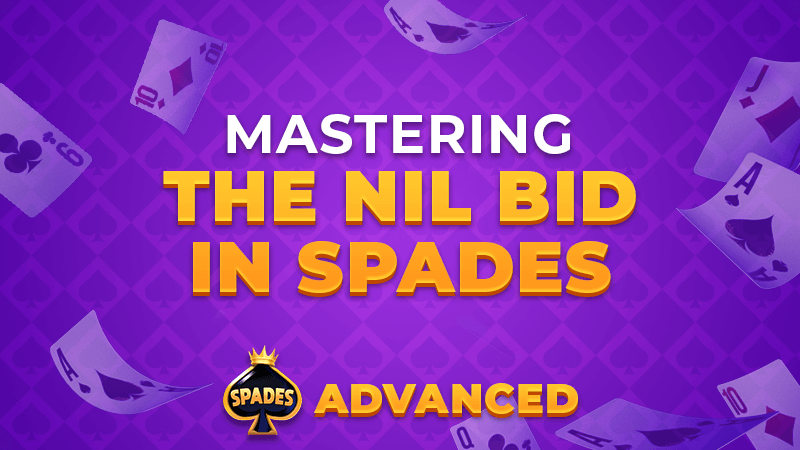Mastering the Nil Bid in Spades

A Nil bid is not just about luck or having low cards. It’s about timing, psychology, teamwork, and precision. In this guide, we’ll break down how to recognize the right moment to bid Nil, what to do once you’ve declared it, and how your partner can help secure it successfully.
1. What Is a Nil Bid?
A Nil bid means you’re declaring that you will not take any tricks during that round. If you succeed, your team earns a large bonus — usually 100 points — but if you take even a single trick, you lose that bonus and suffer a 100-point penalty instead.
Because the reward and risk are both significant, the Nil is one of the most strategic elements in Spades. It tests not only your reading of the cards but also your ability to coordinate closely with your partner.
2. When to Consider a Nil Bid
Not every low hand qualifies for Nil, and not every weak hand is worth the risk. A good Nil requires a specific combination of low cards, suit balance, and timing.
You should consider a Nil bid when:
- You hold mostly low cards (2 through 8) with few middle or high ones.
- Your hand doesn’t contain any Aces, Kings, or high spades.
- You’re not forced to play too many of the same suit.
- Your partner appears to have a strong hand and can help cover you.
Avoid bidding Nil if you:
- Have several middle-value cards (like 9s or 10s) — they can unexpectedly win tricks.
- Hold multiple spades, especially mid-ranked ones (like 9♠, 10♠, or J♠).
- Are in early position and can’t read your partner’s potential strength yet.
3. Reading Your Hand: A Step-by-Step Approach
When you first receive your cards, look for danger zones — suits where you’re likely to win a trick by accident. Here’s how to evaluate your hand systematically:
1. Scan for high cards. If you have any Aces or Kings, a Nil bid is usually off the table. Even a Queen can be risky unless it’s protected by several lower cards of the same suit.
2. Count your spades. Having zero or one low spade (like 2♠ or 3♠) is ideal. Anything higher than 8♠ increases your risk.
3. Assess suit distribution. A balanced hand with 3–4 cards in most suits gives you flexibility to discard high cards safely.
4. Identify your escape routes. If you’re forced to play high, make sure you have another suit where you can “dump” that card later.
Let’s look at a sample Nil-eligible hand:
2♠, 4♠, 6♥, 7♥, 3♦, 8♦, 10♦, 4♣, 5♣, 6♣, 7♣, 8♣, J♣
This hand is low, balanced, and lacks risky mid-range cards. Perfect for a Nil bid — especially if your partner looks strong.
4. Partner Support: Covering a Nil Bid
A successful Nil bid isn’t a solo act. Your partner plays an equally vital role in protecting you. Their goal is to win tricks that you might accidentally take and control the pace of the game.
Here’s how the dynamic works:
- Early in the round: Your partner should lead suits where you’re weakest, helping you discard potential danger cards.
- During Spade plays: They should hold onto high Spades to protect you from getting forced into taking tricks.
- Throughout the game: Communication (through play style, not words) is key. A good partner recognizes when to sacrifice a trick to shield you.
If your partner bids aggressively (say, 5 or 6 tricks), that’s often a sign they have a strong enough hand to support your Nil.
5. Playing the Hand: Techniques for Staying Safe
When playing Nil, every card you choose matters. Here are strategic guidelines to improve your survival odds:
1. Dump high cards early. If your opponents lead a suit where you have a dangerous high card, get rid of it immediately — before the suit becomes risky.
2. Track the suits carefully. If you’re out of a particular suit, you might be forced to play Spades — which could accidentally win. Keep mental notes of which suits you can safely play.
3. Use low Spades sparingly. Play your lowest Spades only when you’re certain they won’t win a trick.
6. When Nil Goes Wrong
Even skilled players occasionally misjudge. The most common causes of failed Nils include:
- Forgetting about a stray mid-value card (like 10♦ or J♣).
- Getting forced into using a Spade too early.
- Partner misreads the play and lets you win an unwanted trick.
If you do break Nil, don’t panic. Learn from the mistake — identify which moment created the risk, and adjust your bidding logic for the next round.
A Nil bid is more than a clever tactic — it’s a psychological play that tests timing, precision, and partnership. To master it, you must learn to read your cards, manage risk, and anticipate every possible danger.
When done right, Nil can completely alter the momentum of a match. But more importantly, it forces you to see Spades differently — as a game of control, not just of strength.
Whether you’re cautiously experimenting with your first Nil or refining your approach to high-level play, remember: every successful Nil is built on calm judgment, perfect coordination, and the courage to take a smart risk.

